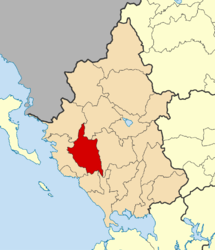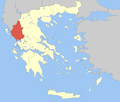Souli
| Souli Σούλι | |
|---|---|
 | |
 Souli Location within the region  | |
| Coordinates: 39°22′N 20°38′E / 39.367°N 20.633°ECoordinates: 39°22′N 20°38′E / 39.367°N 20.633°E | |
| Country | Greece |
| Administrative region | Epirus |
| Regional unit | Thesprotia |
| Area | |
| • Municipality | 502.8 km2 (194.1 sq mi) |
| • Municipal unit | 93.2 km2 (36.0 sq mi) |
| Population (2011)[1] | |
| • Municipality | 10,063 |
| • Municipality density | 20/km2 (52/sq mi) |
| • Municipal unit | 458 |
| • Municipal unit density | 4.9/km2 (13/sq mi) |
| Time zone | UTC+2 (EET) |
| • Summer (DST) | UTC+3 (EEST) |
Souli (Greek: Σούλι) is a municipality in Epirus, northwestern Greece. It was originally settled by both Greek and Albanian refugees who sought refuge in the mountainous terrain from the Ottomans, coming from areas such as Laberia in what became Albania and Thesprotia in what became Greece. In early modern times, it was inhabited by about 12,000 Souliotes.[2][3][4] After their expulsion the population of the region was significantly reduced. In the 18th and 19th century, the citizens of Souli rebelled against the Ottoman rule.
The seat of the municipality is the town of Paramythia.[5]
Name
The origin of the name Souli is uncertain. In the earliest historical text about Souli, written by Christoforos Peraivos in 1803, an oral tradition of the locals is recorded. According to this, the first settlers of Souli were shepherds who came from a village called Gardiki trying to avoid the Ottoman oppression. A certain Muslim ("Turk" in the text) named Soulis attempted to expel the early Souliotes from there but the latter resisted with arms. In the battle they killed Soulis and since then the area was named Souli.[6]
Municipality
The present municipality Souli was formed at the 2011 local government reform by the merger of the following 3 former municipalities, that became municipal units:[5]
- Acherontas
- Paramythia
- Souli
The municipality has an area of 502.770 km2, the municipal unit 93.230 km2.[7]
Province
The province of Souli (Greek: Επαρχία Σουλίου) was one of the provinces of Thesprotia. It had the same territory as the present municipality.[8] It was abolished in 2006.
References
- ↑ "Απογραφή Πληθυσμού - Κατοικιών 2011. ΜΟΝΙΜΟΣ Πληθυσμός" (in Greek). Hellenic Statistical Authority.
- ↑ Vickers, Miranda. The Albanians: A Modern History. I.B. Tauris, 1999. ISBN 1-86064-541-0, p. 20.
- ↑ Ruches, Pyrrhus J. Albanian Historical Folksongs, 1716-1943: A Survey of Oral Epic Poetry from Southern Albania, with Original Texts. Argonaut, 1967, p. 20.
- ↑ Sakellariou, M. V. Epirus, 4000 Years of Greek History and Civilization. Ekdotikē Athēnōn, 1997, ISBN 960-213-371-6, p. 248.
- 1 2 Kallikratis law Greece Ministry of Interior (in Greek)
- ↑ Peraivos Christoforos, History of Souli and Parga, 1815 edition, Venice, p. 18 (pdf 34). In Greek
- ↑ "Population & housing census 2001 (incl. area and average elevation)" (PDF) (in Greek). National Statistical Service of Greece.
- ↑ "Detailed census results 1991" (PDF). (39 MB) (in Greek) (in French)
| Wikiquote has quotations related to: Souli |
